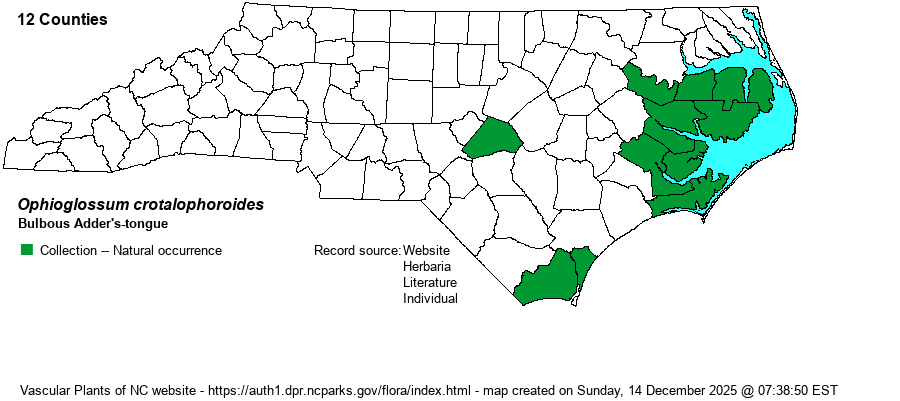| Author | Walter | |
| Distribution | Scattered over the eastern and southern Coastal Plain, mainly in counties near tidal water, ranging north to Martin and Dare counties. The inland record from Harnett County is based on a collection from "short grass, edge of forest" on the campus of Campbell University, where collected by Chris Havren.
This is a Southern species, ranging from eastern NC and southeastern OK south to southern FL and central TX. Also southward to S.A.
| |
| Abundance | Rare or easily overlooked. There are 12 counties with specimens. The website editors feel that the current State Rank of S1? is too conservative, and recommend a rank of S2?. This is a Watch List species. A population on the campus of UNC Wilmington contains thousands of plants (Jessica Roach email June 2021). | |
| Habitat | This species grows in somewhat disturbed places, usually grassy ones that are damp to somewhat wet. Habitats include ditches and ditch banks, grassy roadsides, and even in lawns and at cemeteries. | |
| Phenology | Fruits from March to September, but mainly March to May. | |
| Identification | This is a quite small fern, the full height averaging only about 4 inches tall. Unlike our other adder's-tongues, the plant usually has two sterile blades instead of just one, both very close to the ground surface. This blade is ovate, about 3/4-inch long and not quite as wide, often about 1/2-inch wide. Also, these blades are leathery and have a truncate or almost cordate base instead of somewhat cuneate like others. The fertile blade (spike) is about 1/3-inch long and about 1/8-inch wide, rather stout compared to the rest of the plant. Visually, the species looks like it has two rounded basal leaves in a rosette, with a short "stem" containing a developing spike of flowers to bloom later! Needless to say, it is easily overlooked owing to its tiny size, and even if spotted, passed over as a developing dicot plant. | |
| Taxonomic Comments | None
| |
| Other Common Name(s) | None | |
| State Rank | S1? [S2?] | |
| Global Rank | G5 | |
| State Status | W7 | |
| US Status | | |
| USACE-agcp | FAC link |
| USACE-emp | FAC link |

